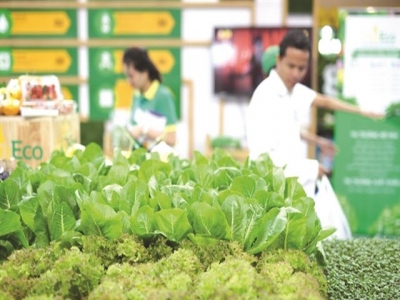Vietnams vegetables, fruits ready to enter choosy markets

The export of vegetables and fruits has resumed. And with the new EVFTA, Vietnam’s products have great advantages to be exported to the EU.
Having just resumed the export of vegetables and fruits to South Korea, Truong Phuc Farm in Da Lat City is hurriedly producing hydroponic vegetables for an order of 30 tons with deliveries in July and August.
“We feel less anxious as exports have resumed,” said To Quang Dung, director of Truong Phuc.
The company has 3 hectares of vegetable growing area of its own and with local households it grows 30 types of vegetables on another 14 hectares. In addition to export, the farm is also providing vegetables to supermarkets across the country.
As for flower growing businesses, some have resumed export to traditional markets such as South Korea, Japan and Australia since mid-May. In addition to air shipping, Da Lat Hasfarm, which exports 80 percent of its products, has tried to export by sea in an effort to increase the market access capability.
Da Lat Hasfarm has lost 40 million flower branches so far this year because of Covid-19. Australia, one of the largest markets, only consumes 3 containers a week instead of 25 containers as seen previously.
The export of vegetables and fruits has resumed. And with the new EVFTA, Vietnam’s products have great advantages to be exported to the EU.
Da Lat Hasfarm has decided to leave 30 hectares uncultivated and reserve 10 hectares for vegetable farming.
According to the company’s deputy general director, it will take 6-12 months to recover the flower export market and take local farmers 3-6 months to fully recover their production.
About the vegetable and fruit export prospect, the Ministry of Industry and Trade (MOIT) said there are positive signs though the epidemic movement remains complicated.
Vietnam’s bananas have officially entered Lotte supermarket chain, while Hai Duong’s and Bac Giang’s litchis have been exported to Japan, China and the US. The Indian market favors Vietnam’s dragon fruit, litchi and rambutan.
Of these, Japan is a big market, which has stepped up the increase of vegetables and fruits from Vietnam, including banana, dragon fruit, lychee and sweet potato, despite the epidemic.
While exports to China, the traditional large market, dropped sharply in the first half of the year ($906.1 million, down by 29.1 percent compared with H1 2019), the exports to other large markets, such as the US, South Korea and Thailand, increased sharply.
The exports to Thailand brought $68 million in turnover (+ 233.4 percent), South Korea $67.4 million (+ 21.8 percent), the US $62 million (+ 6.1 percent), Japan $57.7 million (+ 15.5 percent) and the Netherlands $34 million (+ 9 percent).
Related news
 Vietnamese longans make inroads into meticulous markets
Vietnamese longans make inroads into meticulous markets At present, testing samples of pesticide residues on longan items from Vietnam come up to the stringent requirements set out by these demanding markets.
 Ho Chi Minh City expands high-tech agricultural crops, breeds
Ho Chi Minh City expands high-tech agricultural crops, breeds Ho Chi Minh City’s (HCMC) agricultural sector has experienced a gross regional domestic product (GRDP) growth of more than six percent per year and reached
 Vietnam rice prices plunge to near 12-year low as demand dries up
Vietnam rice prices plunge to near 12-year low as demand dries up Waning rice supplies in Vietnam pushed export prices to a near 2-month peak this week, while a strengthening domestic currency kept rates of the Thai variety